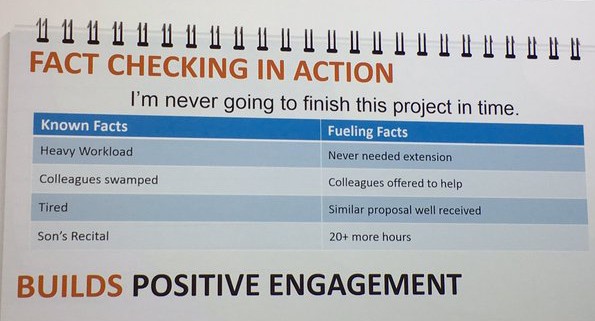A week ago today, I was at the WorkHuman Conference, hosted by Globoforce. Today, as I was facilitating a workshop on Leading Innovation and Change, I was still basking in conference afterglow. Workhuman was packed with insights with some of today’s best thought leaders. Since my workshop was about Leading Change, I thought I’d share some insights on how to Lead Change in a human way, based on thoughts from WorkHuman speakers Shawn Achor, Michelle Gielan, Amy Cuddy and Michael J Fox.
Lead change using design thinking – Inspired by Shawn Achor
Shawn Achor (author of Before Happiness) didn’t actually talk about design thinking, but the research he shared about changing habits make me think of the work being done in applying design thinking to all aspects of work. Achor discussed how, if we make something just 3-20 seconds easier to do, it can change our habit. He shared a story about his intention to learn to play guitar, and how he never actually got around to it until he took the guitar out of its case and kept it within reach on a stand, ready to play. By reducing the time he would usually spend pulling the case out of the closet and the guitar out of the case by 20 seconds, he was able to make playing the guitar a habit.
Applying this to Leading Change:
What processes or changes have you tried to implement that aren’t being followed? How could you make them easier by 3-20 seconds, so that people can follow the process and make it a habit? The easier you can make it for people to fit a new system or process into their current practice, the more likely they will be to implement it. This made me think of the use of design thinking in the OD world. Think of the change you’re implementing from a user experience perspective – how would Netflix or Apple make this really simple and geared to the end user?
Fact check and challenge your assumptions about change – Inspired by Michelle Gielan
Michelle Gielan, a former news journalist and author of Broadcasting Happiness, should know a thing or two about fact checking. When it comes to change, oftentimes the stories we tell ourselves about the negative aspects of the change are based on assumptions, not fact. When you’re struggling to deal with change yourself, follow Michelle’s fact checking process, and guide your employees through it when you’re leading them through change.
Here’s the process:
- Isolate the negative or stressful thought
- List the known facts
- List the “fuelling” facts that illuminate a new story
In the example Michelle shared, the stress is that “I’m never going to finish this project in time.” The facts, which seem overwhelming, are: I have a heavy workload; my colleagues are swamped; I’m tired; and my son’s recital is tomorrow. When we dwell on these things, we can certainly feel like we’ll never finish the project in time. However, when we fact check, we look at what has happened in past situations and what the reality of the facts are, so we see that:
- we’ve never needed an extension before
- in the past, our colleagues have offered to help us
- we’ve had similar proposals well received
- we have 20+ more hours to work on this, even with our son’s recital in the mix

Once we do this, we can move forward past the overwhelming feeling.
Applying this to Leading Change:
The same thing can work as you lead your team through change, having them fact check their assumptions about how terrible the change will be, thinking about how they’ve made it through changes in the past, and what the reality of the change is so that they can determine how to move forward.
Fake power and confidence in change until you are powerful and confident about it
Amy Cuddy, who has one of the most watched TED talks of all time, shared how “your body and mind are in constant conversation, and your body is leading that conversation”. As we intentionally set our body language, our mind begins to actually change, so we can actually fake power and confidence until we become powerful and confident.
Amy shared images of powerful and powerless poses, and research that shows that assuming a powerful pose actually helps people feel more powerful.
Have people stand for 2 minutes in a power pose or powerless pose. Power pose -> feeling of power #WorkHuman pic.twitter.com/u31AwFfNG2
— Pam Ross (@pamelamaeross) May 10, 2016
Applying this to Leading Change:
This body language research helps us to lead change in a few ways. First of all, when a change is being implemented or done “to” us, we often feel powerless. When we feel that way, practice power poses, and this should help you to speak up, share your thoughts, and feel more powerful about how you deal with the change. Secondly, power posing prior to communicating change to your team will help you to exude more confidence in them and in the change.
Be honest about change but don’t worry about it – Inspired by Michael J Fox
If there’s anyone who’s gone through some massive changes, met them with resilience and optimism and come out on top, it’s Michael J Fox. He shared stories and insights with humour and humility, and most of all, humanity. (Sidebar – his book Always Looking Up is one of my all-time favourites).
Michael J Fox talked about how being honest about his Parkinsons, and keeping track of its effects, allows him “all of this other space to fill up with life, family, work, hopes and more.”
Another insight from Michael J Fox was his thoughts about worrying about things. In his words,
“When you worry about the worst happening and it does, you go through it twice.”
Applying this to Leading Change:
When leading change, it is important to be honest about both the benefits and the risks or challenges of the change you’re implementing. Being honest about everything helps people to realize what they’re dealing with so they can move forward. When you and your team deal with change being implemented, it’s easy to worry about all the negative pieces of it, the impact it will have on you, and what might happen. Instead of focusing on all of these worries, focus on solutions, and if the worst does happen, you only suffer once.
Overall, my WorkHuman Change Leadership advice is:
- When you’re leading change, you need to buy into it yourself before you can authentically help others through it
- Accepting change or any challenge is often about changing your mindset. One of my favourite quotes from WorkHuman came on day 1, when Michelle Gielan talked about how you can “Change your Story, Change your Future”. I think this is so relevant today, as changing your story breeds resilience, which is so important when dealing with the rapid pace of change we are experiencing
- We are all broadcasters, and how we act, what we say or do, has an impact on others. Leading positively will have an impact on other’s ability to see things in a more positive light.
Finally, if you want to be inspired, and to learn insights that you can implement and action in change leadership and all aspects of your work world, I encourage you to go to WorkHuman in Arizona in 2017! You can register now here.


